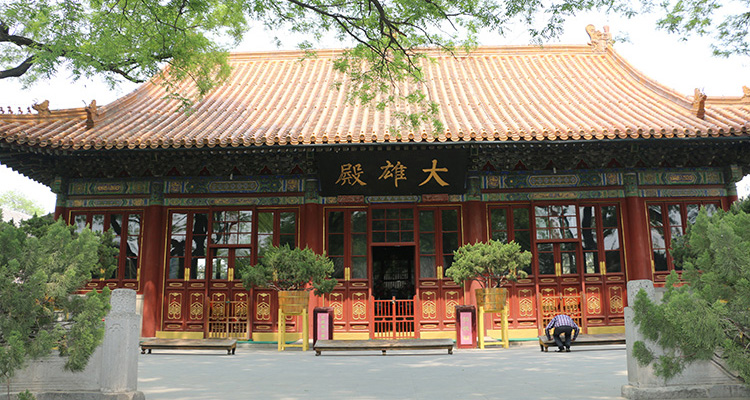Beijing Guangji Temple: Explore Historic Halls and Buddhist Traditions
1. Step Into History
Nestled in the bustling Xisi district of Beijing, Guangji Temple sits quietly with its red walls and yellow tiles, offering a serene escape amid the city’s hustle and bustle. As the headquarters of the Chinese Buddhist Association, Guangji Temple is not only a hub for Buddhist activities but also a sacred site carrying over 800 years of history. Towering ancient trees and tranquil courtyards create a peaceful retreat for visitors seeking calm.
The temple dates back to the Jin Dynasty, originally named “Xiliucun Temple.” In 1457, monks Puhui and Yuanhong rebuilt the temple on the old site. In 1466, Emperor Xianzong officially named it Hongci Guangji Temple. During the Qing Dynasty, it became a Vinaya school temple with a dedicated ordination platform.
Modern history brought challenges: a fire in 1931 destroyed the temple, and it was reconstructed in 1935 following the Ming-style layout. In 1953, the Chinese Buddhist Association established its headquarters here, making Guangji Temple a national center for Buddhist affairs. Its architecture retains the Ming-era layout, and it was recognized as a national key Buddhist temple in 1983 and a national heritage site in 2006.

2. Marvel at Architecture and Art
Guangji Temple features a strict central axis layout: the Shanmen (Mountain Gate), Hall of Heavenly Kings, Mahavira Hall, Guanyin Hall, and Duobao Hall.
- The Shanmen has three bays with yellow glazed tiles in the center and green tiles on the sides.
- The oldest structure is the Vinaya Hall in the northwest corner, housing Beijing’s only Qing Dynasty marble ordination platform.
The Mahavira Hall is the temple’s grandest building, with a yellow-glazed single-eaved roof. Its ridge features the “Sea of the World” (香水海), crafted from glazed bricks with water waves, lotus flowers, and Sanskrit motifs, symbolizing the eternal world—a unique feature in Beijing. In front stands a bronze cauldron from 1793, two meters tall, adorned with Buddhist eight-treasure patterns.
Behind the hall hangs a giant finger-painting, Victory and Sublime Sound, created in 1744 by Fu Wen by imperial command. Measuring 5 meters high and 10 meters wide, it depicts Shakyamuni preaching to devotees, including historical figures like Guan Yu, Guan Ping, Zhou Cang, and the Laughing Buddha, brought vividly to life with expressive detail.

3. Religion and Culture
Guangji Temple houses numerous Buddhist statues with immense religious and artistic value.
- In the Hall of Heavenly Kings, visitors find a Ming Dynasty bronze Maitreya Buddha and the Four Heavenly Kings in Tang-style sancai colors. Unlike other temples, this hall features a crowned Maitreya instead of the typical laughing Buddha.
- The Mahavira Hall enshrines the Three Buddhas of the Past, Present, and Future and Eighteen Arhats.
- Guanyin Hall (Yuantong Hall) houses Guanyin Bodhisattva, said to be especially effective for those seeking love. Its west side holds a Yuan Dynasty bronze Avalokiteshvara, and the east side features a Ming Dynasty Tara, representing Tibetan Buddhist traditions.
Daily rituals include morning and evening chanting, with monthly Dharma lectures. Visitors with good timing may enjoy vegetarian meals prepared by the temple. The front courtyard displays unique steles, including one gifted by Emperor Kangxi, paired with a blank stele, symbolizing the emptiness and presence of Buddhist truth.

4. Visitor’s Guide
Dress & Etiquette
- Wear modest clothing, avoiding revealing outfits.
- Maintain silence and respect the sacred space.
- Do not touch statues or relics.
- Non-Buddhist visitors should avoid entering the worship areas.
Suggested Route
Begin at the Shanmen, then proceed to the Hall of Heavenly Kings, Mahavira Hall, Guanyin Hall, and finally the Duobao Hall. The Qing Dynasty marble ordination platform in the northwest corner can be admired from a distance. A full visit usually takes 1–2 hours.
Best Season to Visit
All year round, with spring and autumn offering pleasant weather and lush greenery for a more tranquil experience.
5. Practical Information
- Opening Hours: 7:00 AM – 4:30 PM (last entry at 4:00 PM)
- Tickets: Free, no reservation required
- Transport:
- Subway: Line 4, Xisi Station, exit A, short walk to the temple
- Bus: Routes 13, 42, 102, 603, 604, 619, 623, 685 to Xisi North Stop
- Car: Navigate to “Guangji Temple”; parking available but limited—public transport recommended
Guided Services
- Free incense offered at the entrance (1 or 3 sticks)
- Multilingual guides can be arranged through advance booking
Nearby Attractions
Walk to White Pagoda Temple, Imperial Ancestral Temple, and Wansong Old Man Tower to explore more historical sites.

Beijing Guangji Temple, blending imperial grandeur and Buddhist culture, invites you to experience over eight centuries of living spiritual heritage. Here, you’ll feel the depth of traditional Chinese Buddhism and the vibrancy of its ongoing cultural life.


